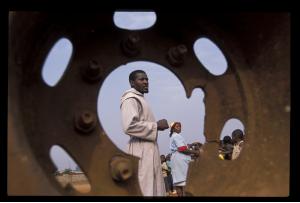 |
| The school founded by the
Trappist monks of Koutaba, Cameroon, welcomes more than 500
students and has become the most renowned in the region. -- Photos by Laurent Larcher |
By LAURENT LARCHER
The call to prayer rises in the silence of this Cameroon night. The beating of the tam-tam, swelling, wakes the monks from their sleep. Here, the percussions and the rhythms of Africa have taken the place of the antique chimes of the sons of St. Bernard. One by one, the Trappist brothers, enveloped in their cowls or their white capes, direct themselves toward the chapel.
The night is fresh; it is 3:30 a.m.
By the feeble glow of a few light bulbs, their silhouettes stand out in the dimness. There are 20 of them. Most are younger than 30. The stalls in braided straw of this former barn fill up bit by bit. Once the community has gathered together, Fr. Germain Mbida Mbida, superior of Notre-Dame de Koutaba Monastery, intones the first office of the day: Matins.
At 46, he is the first Cameroonian to lead this community since the arrival of the Trappists in 1951. Fr. Germain went through formation at Notre-Dame d’Aiguebelle, a Trappist abbey in France, under the direction of Fr. Christian of Chergé in the 1970s, and was elected prior by his brothers in 1996.
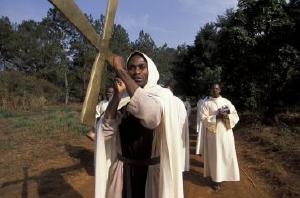 |
| The monks carry a cross to the site of their monastery. |
After a little less than an hour, silence and darkness invade the premises anew. All remain awake and watch until the sixth hour, the hour of Lauds. The lectio divina punctuates the last passing of night. The dawn finishes crossing the monochrome stained glass windows of the chapel, gradually revealing the faces of the monks. They are Cameroonians for the most part, but there are also among them some Central Africans, Kenyans, Gabonese, Congolese and three French.
Fr. Georges Delomier, monk of Koutaba since 1972 and the community’s novice master, recalls the history of their founding: “The first group of founders sent from Aiguebelle installed themselves in the forest of Ouboub, near Douala. Their mission? To inculturate Cistercian monasticism on African soil. It was not simple. Everywhere they met obstacles. Solitude, simplicity, the indispensable silence of monastic life were not respected. It was necessary to move away from there. That’s why they installed themselves in Koutaba, on the savanna of the high plateaus, about 4,000 feet in altitude.”
Another reason determined their choice. “The monks had to live by the work of their hands,” said Fr. Georges. “The region, rich in water, is favorable for growing coffee. That had not escaped from the Germans [colonial rulers of Cameroon, 1884-1916]. Counting on the altitude, they had planted Arabica, definitely fruitier -- and try to find any more robust -- than that of any other region in Africa. The monks were established in one of these plantations, taking up [49 acres]. The local premises and the machines dated from 1905.”
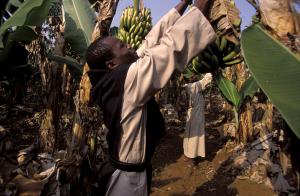 |
| Brothers pick bananas on the monastery's plantation. Their principal crop is coffee. |
The tam-tam sounds anew. It is time for work. The brothers set off for their jobs. The monastery produces 10 to 12 tons of coffee per year. Koutaba employs about 20 permanent workers and 200 salaried employees for the harvest, extending the influence of the community far past the limits of the theoretical enclosure of the monastery. Sensitive to the poverty of the neighboring villagers, the monastery has put in place a network to carry water from wells. It has also built a school that educates 500 children.
The involvement in the human and economic reality of the high plateaus is one of the aspects of their deep roots in African culture. The visible sign of this inculturation expresses itself in the liturgy. They rethink it and reinterpret it by using traditional instruments like corats and the tam-tam. Dance is done, too, as they enter into the Office of the Hours. The songs and the texts are translated or written in Bamileke and Beti, two principal ethnic languages of the country.
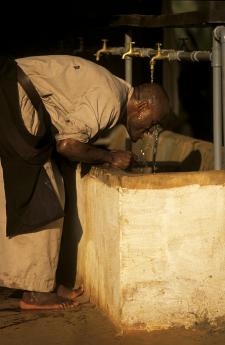 |
| A monk washes up at the end of the day. |
“The church of Cameroon is aware that the mystery of Christ touches all areas of human existence: our bodies and our spirits,” said Fr. Germain. “In Africa, life is celebrated with songs and dances: births, marriages, mourning periods. … We go to meet the invisible through the dance. It is our tradition and our culture. To dance before God, it is to meet him with all our being. There is nothing exotic or superficial about it.”
From this point of view, Koutaba is a veritable laboratory for inculturation. On the subject, the prior is inexhaustible. “With authentic monastic values and docility to the Spirit, the monastery of Koutaba must join in with the African people’s ability to be open to their universe, that is to say, their culture. By virtue of its composition, our community is a meeting point between the Western world and the African world. The monastic life is necessarily conditioned by the Western culture in which it has developed over the course of history. The gift of contemplative life from one church to another presupposes that its members will make an effort of opening from a church that is bare, methodical and disinterested to one that is welcoming. … The monastery of Koutaba itself must discover the African person through a whole scope of values by uniting African people in their similarities, uniting them to the surrounding world and to divine transcendence -- people in solidarity. These values -- to be together, share, listen and give mutual respect -- help create a favorable space, one that is apt for welcoming the new spiritual values that convey the traditional monasticism of the church.
“The discovery of the ‘proper genius’ of the African people is a fundamental requirement for a happy future for the community of Koutaba. It’s because Africans will feel the profound pull toward the human and the spiritual that they will be able to open themselves to the measure of the gift of the Cistercian monastic tradition. Both sides must open to each other. Both sides, the monastic tradition and the African, must go out to meet the other. And one must always remember that the Gospel, the Word of God, defines and judges any culture. Carried out in the truth, in the conscience of personal identity and in mutual respect, the meeting of the African soul and the monastic life will cause something new to rush out of those ancient sources.”
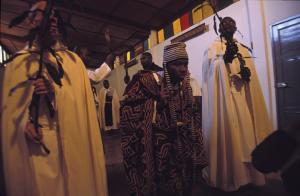 |
| In a liturgy, a monk carries the Gospel on his back, as the community shows the honors due to a king or a chief. With dance and chant, the monks adapt and reinterpret the Western tradition for African culture. |
It is true that the renown of Koutaba exceeds the frontiers of the region. The demands for admission come from all African countries, from Sudan to the Ivory Coast, from Rwanda to Mali.
Not all the demands are serious. “For many young Africans, the church represents a chance for climbing the social ladder,” said Fr. Georges. “Entering Koutaba seems like going to Europe, to France or Italy. The temptation is great. … We should be extremely vigilant for the good of the young, but also for the equilibrium and the credibility of our community.”
At the moment, there are 40 who have been accepted for a trial period, but who wait outside the monastery. “Our location is too small. We cannot have more than 20 people here,” said Fr. Georges.
The present location’s lack of privacy, dilapidation and ill-adaption to the region have led the monks to decide to build a real monastery. It will be a new stage in the inculturation of the Cistercian model on the ground of Africa. Their project will be to reconcile the Cistercians’ “beautiful simplicity” with traditional habitat.
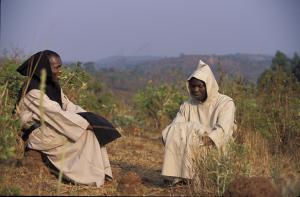 |
| Requests to join the monastery from all over Africa. Here, Brother Yvon counsels Brother Bruno, a young novice from Central Africa. |
The wall, the cloister, the buildings and church will be constructed of the same earth as the high plateau. The riches of the region are immense. The terrain consists of red earth with important outcrops of basalt and volcanic rock. The Architecture School of Montpellier, France, is going to supervise the making of the clay bricks, of cinderblocks in concrete and volcanic rock, and locally made tiles.
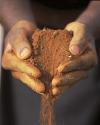 |
| The earth of Koutaba |
The future monastery will be the first in Africa to be inspired entirely by the traditional habitat and to turn resolutely away from models inspired by Europe. “With this monastery, we want to signify the rooting and the specificity of the church in Cameroon,” said Fr. Germain. “Daughter of Aiguebelle, daughter of Europe, it is time for Koutaba to grow up. It’s for us to know how to sketch the African visage of the Christ revealed.”
The tam-tam sounds a second time to call the seekers of God to the office of compline. The choir of monks take up a final exhortation: “Now, Oh Master Lord, you can leave your servant to go in peace, according to your words.” It is the ultimate prayer accompanied by the corats of the African savanna.
Laurent Larcher is a staff writer and photographer with Pélerin, a French Catholic magazine. This story was translated from the French by NCR staff.
Cameroon Facts
Source: CIA World Factbook Related Web Site |
National Catholic Reporter, February 27, 2004